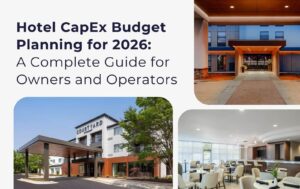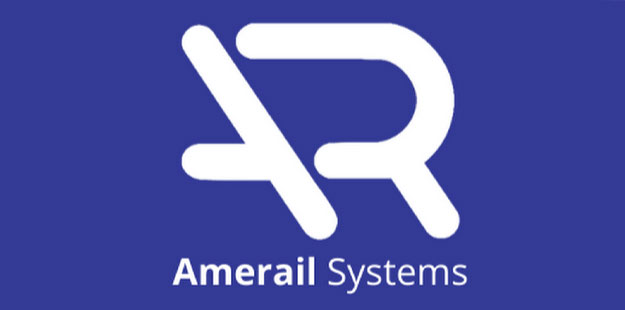PIP 101: What Every Hotelier Needs to Know
Staying competitive and meeting the evolving needs of guests is essential to a hotel’s long term success.
One of the most common responsibilities in a hotelier’s career is fulfilling PIPs and completing hotel renovations.
A PIP or Property Improvement Plan, is a detailed set of renovation requirements issued to hoteliers by their brand. This plan ensures the property stays aligned with the brand’s continually updated standards.
These plans are issued every 5-7 years and draw attention to the areas of the hotel that need improvement.
Though PIPs may sound daunting, the key to tackling them is preparation.
It’s essential for owners to recognize the early signs of an upcoming PIP renovation so they can prepare, budget strategically, and stay ahead of the game.
Declining Guest Satisfaction Scores
One of the clearest indicators that it’s time to prepare for a PIP or renovation comes directly from guest reviews.
It’s easy for hoteliers to overlook how many parts of a property need updating, but rest assured, guests never miss them. Even issues as simple as a cold shower, outdated furniture, or lack of tech can shape a guest’s entire impression of their stay.
We recommend that owners regularly check their guest feedback to stay in touch with how the property is perceived.
In today’s digital world reviews appear everywhere, not only on your website, but also on social media and third-party platforms. Guest reviews may seem like they highlight every flaw, but in reality, they help hoteliers identify which upgrades to prioritize.
Noticeable Wear and Tear
With guests coming and going around the clock, wear and tear is inevitable.
However, if ignored, it can negatively affect how guests perceive your hotel and may lead them to question its overall cleanliness. Hotels with high occupancy naturally experience wear and tear faster than those with lower occupancy.
The areas to keep an eye on are any of the high-traffic public spaces, including:
Lobbies
Fitness Centers
Dining Rooms
Breakfast Areas
Dining spaces and markets are particularly vulnerable, as signs of aging can give guests the impression that the space isn’t sanitary. Guests don’t want to be greeted by worn carpets, stained furniture, or scratched floors and neither would you.
We recommend scheduling routine evaluations and addressing visible wear and tear in public spaces early, before it impacts guest satisfaction.
Operational Inefficiencies
Operational inefficiencies don’t just show up on paper, they’re also noticeable to guests. Aging systems such as HVAC, lighting, and plumbing often lead to higher expenses and dissatisfied guests.
Your HVAC system is one of the most vital elements of your property’s success. Poorly operating HVACs not only drive up your bills, but also drive guests away. Summer or winter, your guests prioritize comfort and temperature control.
In fact, we recently conducted a LinkedIn poll to see which guest comfort feature ranks highest, providing these four options: Blackout Curtains, Air Conditioning, Fast Wi-Fi, and Mini Fridge. Air Conditioning finished in the lead with an overwhelming 76% of votes.
If you’re seeing your utility bills rise and your guest satisfaction fall, it might be time to consider an upgrade. Unfortunately, sometimes the solution isn’t as obvious as replacing a weary HVAC system. When evaluating your HVAC system, we recommend starting by checking the condition of your doors and windows. Pay special attention to issues like rust, difficulty of use, or noticeable drafts. These are signs that outside air is seeping in and your HVAC system is working harder than it should. They’re also a clear sign to schedule a consultation with us and start planning an upgrade.
In addition, other outdated systems such as lighting and plumbing can wreak havoc on an owner’s wallet and on a customer’s stay.
While a dim bulb might go unnoticed, a maintenance call is something guests won’t forget. This makes it essential to prioritize energy efficiency while cutting down on maintenance costs. Proactively upgrading these systems not only reduces unexpected breakdowns but elevates the guest experience. Energy-efficient lighting, windows and modern plumbing, create a more enjoyable stay, cut utility expenses, and help eliminate disruptions.
Utility upgrades also shrink your property’s carbon footprint, aligning your hotel with the growing emphasis on sustainability while protecting both your reputation and your bottom line.
Competition is Raising the Bar
Staying competitive is the name of the game in the hospitality industry. The hotel market is always shifting, with new brands emerging all the time. Newer or recently renovated hotels can make your property look dated, even if it is in good condition. Guests naturally compare hotel options and an older looking property may seem less desirable in comparison.
As a hotelier, you’re competing not only with new brands but also with properties within your own brand. Staying aware of the industry and market trends will help put you a leg ahead. One of the best ways to decide where to allocate funds is by watching where your competitors are investing.
We recommend regularly assessing local and brand wide markets to spot where investments are paying off. Of course, every hotel’s needs are unique, but watching competitors can help spot broader trends.
For example, we’ve seen a growing focus on wellness spaces in our recent renovations. Fortunately, a skilled renovation team keeps you in the loop on industry trends and highlights what’s becoming a key focus for other hoteliers.
Financing and Budget Alignment
It’s no secret that PIPs include a timeline, which means the earlier you begin planning for a PIP renovation, the better. Planning in advance allows for phasing the renovation, easing cash flow management, and reducing operational disruption. It also allows your renovation team the time to provide detailed and accurate estimates.
We recommend reaching out as early as possible to discuss timelines, since the pre-construction phase can take roughly 3–4 months. Proper planning minimizes unexpected surprises and helps alleviate the time pressures associated with PIPs.
Opportunity to Maximize ROI
You have to spend money to make money and PIPs are no exceptions. Luckily a newly renovated hotel is an opportunity to boost revenue through occupancy and ADR (Average Daily Rate). Renovations aren’t just maintenance, they are an investment into your hotel’s future.
Investing in a refreshed property will naturally attract more bookings than competitors who are delaying necessary upgrades. In fact, delaying a PIP can cost more in lost revenue than the renovation itself. In addition, improvements to rooms and amenities justify an increase in room rates.
If you’re seeing a dip in your bookings or are considering decreasing your ADR, it may be time to start planning and saving. We recommend prioritizing timely PIP renovations to protect and grow your revenue. The sooner upgrades are completed, the sooner your property can attract higher occupancy, command better rates, and maximize return on investment.
Outdated Brand Standards
One of the clearest signs to prepare for a PIP comes from your brand itself. If you notice your brand rolling out new color schemes, layouts, furniture, or branding it’s a clear indication that a PIP isn’t far behind.
Franchise brands regularly update their brand standards to maintain a modern, cohesive, and relevant look across all properties. While each property is unique and features its own specialties, the overall brand look must stay current. Otherwise, the property may fall out of alignment with the brand and be required to undergo a full conversion.
By staying on top of brand updates, you can act promptly and buy yourself some buffer time. The better prepared you are, the stronger your position is in negotiating your PIP. We recommend staying proactive by monitoring your brand’s standards and updates. As soon as you begin to notice these adjustments, reach out to us to begin preparing for a PIP renovation.
Conclusion
In the highly competitive hospitality industry, staying ahead is essential and being proactive is key. Every 5-7 years, a PIP will come around, but being prepared ensures you stay ahead of that timeline. By recognizing the early signs of an upcoming PIP, hoteliers can minimize surprises, estimate costs, plan strategically, and connect with a renovation team they trust. Selecting the write renovation team is critical. Partnering with an experienced hotel renovation team like Amerail Systems ensures you’re never navigating a PIP alone, we’ll guide you every step of the way.




